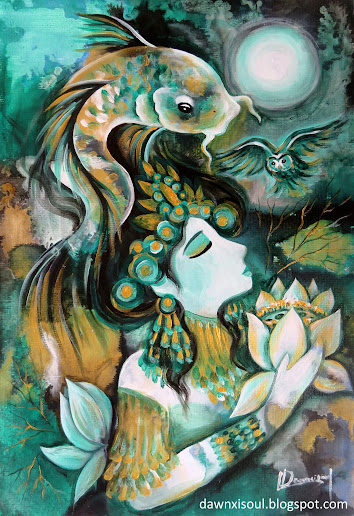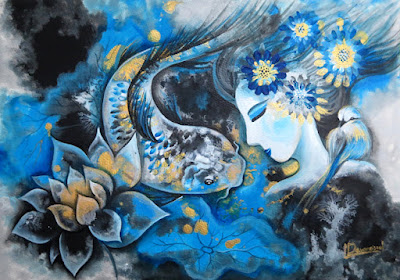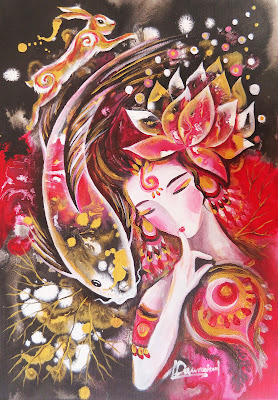July 20 (Lunar calendar: June 3), 2023 Thursday | Dawnxisoul393art
《The Magic Lotus》, painted by dawnxisoul393
First Part: The Soul of the Lotus
Living in Hong Kong, a maritime subtropical monsoon climate region with four distinct seasons, beautiful lotus flowers can be seen everywhere, and we have grown up with a love for lotus flowers. If everything in the world has a soul, then the beauty of the blue of the sky and the sea, the beauty of the green of the mountains and the water, the lotus is their soul. If there is no lotus soul, if there is no lotus spirit, if there is no lotus persistence and resilience, if there is no lotus "out of the mud, but not dyed" high moral character, today, presented in front of us, that will be a world full of dirt and stink everywhere. Thanks to the perseverance of the lotus-like soul, there is a beautiful scenery of spring, summer, autumn, and winter, and a charming world of the river and the sea in a thousand years.
Illustrated by dawnxisoul393
The lotus' delicate beauty is certainly lovely, but that is only a superficial phenomenon, the real connotation of the lotus lies in the inside, in its inner soul. The lotus grows in the sludge and blooms on the surface of the water, and it has the deeper meaning of coming out of the sludge but not being dyed. The lotus is an aquatic plant, water is the source of life, as long as there is the right water and soil, it will grow, blossom, and has seeds. Where there is water, there are lotus flowers, and where there are lotus flowers, there are lotus seeds. In the cycle of lotus life, there is always a spiritual thing flowing like water. Every time we see a lotus flower, it always gives us a kind of respectful admiration and impulse. The lotus is worthy of being a rare and wondrous flower in the plant world.
Illustrated by dawnxisoul393
Before the emergence of mankind, in that ancient time when it was still barbaric, the lotus came in the vast and endless swamp. The lotus seeds are so vital that scientists have been reported to have produced flowers in the laboratory from lotus seeds that have been dormant underground for thousands of years. Just as the lotus blooms to its fullest, the seeds grow at the same time, maturing as the lotus fades. At this time, the lotus seeds are simple and unpretentious, a modest gentleman's demeanor, clinging to the black and hard shell, protecting the light green lotus bud inside. In the long summer season when the trees are thickly shaded, it is also the time when the lotus flower blooms most abundantly. The lotus gives people much deeper thoughts than its meaning as a plant itself, and people take it as a symbol of elegance and purity.
Illustrated by dawnxisoul393
In the pond, the quiet surface of the water is covered with emerald lotus leaves, like a dense emerald umbrella, covering the surface of the water tightly. The sea breeze sends a gust of lotus fragrance, and the turquoise lotus leaves were rolling with fluorescent dewdrops, like layers of green waves, like pieces of emerald jade. The buds burst out of the sludge, the budding buds, some standing proudly on their stalks, some hidden under the leaves, all of them carefully receiving the feeding of the roots and the nurturing of the leaves. When the flowers bloom, a single lotus flower stands out from the bright green leaves. The fragrant lotus flowers are like shy maidens, blushing and smiling, and the lotus leaves are infinitely blue, and the lotus flowers are red. When the flowers fade, they leave behind not only beautiful memories in people's minds but also lotus seeds that sway gently in the wind.
The lotus is not as graceful as the peony, or the plum blossom, however, she silently emits fragrance and sends coolness to the world in the heat. The lotus does not leave its beauty in the spring when the light of spring is interesting, the birds are singing, and the flowers are growing, but chooses the summer as its booming season.
In the sun, they are charming, in the wind, they are dancing, and in the rain, their skin is smooth and moist. The lotus dedicates its beautiful flowers to the summer, but it has no regrets, that is because the lotus is not weak, but brave. The brave ones certainly do not think of summer as a cage, no wonder the lotus can bloom fragrant flowers, greeting the upcoming harvest of golden autumn. Whenever we finish our day's work in summer, the thing we want to do most is to go to the quiet lotus pond to enjoy the beautiful lotus flowers, hoping to use their coolness to eliminate our anxiety in the summer heat. Whenever we come to the lotus pond, looking at a pool of blue water, enjoying a pool of lotus flowers, and immersing ourselves in a pool of seclusion, there is a burst of lotus fragrance floating towards our heart, soothing our tired hearts. The lotus is also a kind of people-friendly plant, they do not compete with the grains for land, they do not compete with the grasses for the favor, they can settle down in any pond and swamp, ditch, or river.
Illustrated by dawnxisoul393
In the spring, they give up the wonderful flowering period to other plants. In the summer, they make every effort to open beautiful and colorful flowers for the earth, bringing people a refreshing. In the fall, they hold the lotus seeds, which carry their hopes for a new life, high above their heads and in the sky, as the lotus seeds ripen, they return to the pool, following the waves to new waters to grow and develop. In winter, they bury their roots deep in the bottom of the pond and wait for the next year's old roots to sprout a new green. In the early days of Hong Kong, it was a popular custom that when a boy in the family married, on the day of the wedding, the mother-in-law would always give her daughter-in-law a bowl of lotus seed soup with a handful of lotus seeds, a few lotus petals and a few pieces of lotus root in order to pray for her daughter-in-law to have a baby early, which actually meant that the powerful life force of the lotus flower was incorporated into the life of the new generation.
Illustrated by dawnxisoul393
In the life of the lotus, the lush green of the leaves is its true color, the redness of the flowers is its frankness, the stubbornness of the stems is its will, the toughness of the roots is its commitment, and the dedication to the benefit of others is its character. The lotus grows in the sludge, but blooms on the water. In high summer, the green stem of lotus stands on the mirror-like water with its noble and upright posture, and the beautiful lotus flowers protrude from the green leaves. We love lotus flowers, we love their beautiful maiden-like posture, however, we love them even more for their high-minded souls that are undefiled by the mud. Laozi, the originator of Taoism, believed in the Tao Te Ching that the laws of man, heaven, earth, human beings, and even the entire universe are all connected and that people should learn about life and discover its true meaning from nature. The lotus flower, like other plants and flowers, can give enlightenment and help people understand many truths of life.
People with high realms can understand three symbolic meanings of the lotus flower, which go far beyond something as simple as "spotlessness". The first realm - cleanliness, not forgetting the original intention, should be like the lotus flower "out of the mud and not dyed", the gentleman is open and honest, adhering to the quality of chastity, purity, innocence, and cleanliness. The second realm - tolerance and absorption, the sea knows how to tolerate and absorb a hundred rivers, and finally to have a large capacity, the lotus is nourished by the sludge, in order to grow better and better. Similarly, people should know how to tolerate everything, and draw nutrients from the "fertile soil" of setbacks and tribulations to strengthen their bones and grow their minds and abilities. Humility and prudence, tolerance of all things, yin and yang peace, in order to become stronger and stronger. The third realm - before the flowers bloom before the moon is full - is the most beautiful moment to seek flowers and wait for the moon. This is the unchanging truth of nature. The higher the realm, the more people can understand the third realm of the lotus.
Illustrated by dawnxisoul393
When we are young, especially in college, sometimes we treat people too strongly, just like a lotus flower, high and clean. But after we reach middle age, we should learn to be tolerant, content, and not arrogant. We already know that if we understand these three realms of the lotus flower, we will understand life better.
Second Part: Lotus and Sakyamuni Buddha
Lotus and Buddhism are very close, the lotus is the symbol of Buddha, the lotus in Buddhism means beautiful, holy. The scriptures say that Siddhartha's mother had large, beautiful, clear eyes like lotus flowers. When Prince Siddhartha(Sakyamuni Buddha)was born, there were eight kinds of auspicious appearances in the imperial palace, one of which was a white lotus flower as big as a wheel growing in the pond. The white lotus flower grew when the birth of Prince Siddhartha on earth, Prince Siddhartha was born at the beginning of the tongue and flashed a thousand golden lights, each golden light and turned into a thousand leaves of white lotus flower, In the middle of each lotus flower sits a small Bodhisattva with his legs crossed and the feet of his feet facing upward. The little prince opened his eyes and stood up happily, unaided, and took seven steps.
Illustrated by dawnxisoul393
Every step the little prince took, a lotus appeared on the ground, a time, the earth shook, the fragrant wind scattered, the rain, the fairy music played, the gods praise. The Western blissful world is compared to the pure and undefiled lotus realm. According to Buddhism: "the flower blossoms to see the Buddha-nature", the flower means the lotus flower, the flower blossoms means that the practitioner reaches a certain state of wisdom, metaphorically speaking, when a person has the state of mind of the lotus, he will show the Buddha-nature, the lotus flower, representing a state of wisdom. The Buddhist scriptures say that the lotus on earth has at most tens of petals, the lotus in heaven has at most hundreds of petals, but the lotus in the Pure Land has more than a thousand petals.
Illustrated by dawnxisoul393
When we walk into a monastery, we all see many statues of Buddha and Bodhisattva, as well as the scenery of the monastery, the Dharma objects, almost all of which are related to the lotus. The symbolic meaning of the lotus is that Buddhism can bring people a cool and calm state of mind on troubled earth. All sentient beings in the three realms, whether born in the womb or in the egg, are born from lust, but the saints in the Pure Land are born from the lotus. The lotus flower indicates pure virtue and cool wisdom and represents the pure Dharma body. In ancient India, there has been a culture of loving the lotus since ancient times. In India, the lotus was regarded as a symbol of gods and the national flower of India, therefore, after the birth of Buddhism, in order to facilitate the public to accept the teachings, the lotus was also used as a metaphor for Buddha, which eventually spread widely.
Illustrated by dawnxisoul393
In Buddhism, there are countless words that use lotus as a metaphor, the Buddha's seat is called "lotus seat" or "lotus platform", Buddhist scriptures call the Buddha's kingdom "lotus world", the Buddhist disciples call each other "lotus friends", call temples "lotus houses", call monks' robes "lotus clothes". Buddhist scriptures say that using lotus seeds as rosary beads is better than using wooden beads, the same chanting once, the blessings can be obtained a thousand times more. The lotus is the Buddha, the Buddha is the lotus, the two have been inseparable. The lotus, a perennial aquatic plant, has won the supreme worship of Buddhism for its "undefiled" nature and its ability to bloom against the scorching summer sun. Buddhism considers the "Six Dusts", as the world is full of "Six Dusts", so the human world is called "Six Dusts World". Because of the pollution of the "Six Dusts", the human world is full of desires and competition, making it difficult for people to have inner peace and clean behavior.
In order to enter the Buddha's kingdom, one must stay away from the earthly world, enter the pure and empty gate, and concentrate on Buddhist practice to eliminate pollution. The special property of the lotus flower to be free from pollution is consistent with the desire of Buddhists in the human world to keep themselves free from the pollution of the earthly world and to remain clean in order to enter the Pure Land of Buddha. In India, in the summer, when the sun burns like fire, it is the season when lotus flowers are in full bloom. In the summer night or early morning, when people walk around the ponds and lakes where lotus flowers are in full bloom, the breeze blows and the fragrance of lotus flowers emanates from the dense lotus leaves with the wind, making people's body and mood as cool as if they have been washed by water. In the Buddhist scriptures of India, the classification of the lotus is also associated with Buddhism, which is very different from today's scientific classification, and the meaning of lotus in Buddhism is wide including different genera of water lilies and so on.
Illustrated by dawnxisoul393
In terms of the color of the lotus, there are five colors in the scriptures, including white, blue, red, purple, and yellow, which are called the "five kinds of heavenly flowers. Among them, white and green are the most popular. The petals of white and blue lotus flowers are distinctly blue and white, resembling the wise eyes of Buddha. The Lotus Temple in New Delhi is located in the middle of a lawn. From a distance, the Lotus Temple looks like a white lotus flower in full bloom, standing on this lawn, a piece of pure land, revealing everywhere the spiritual temperament of "out of the mud but not stained". Lotus Temple was completed in the 1980s, the whole building consists of three layers of petals, each layer of nine pieces, the reason for the adoption of the shape of the lotus has a lot to do with the history of India, the lotus is not only a Buddhist deity but also the national flower of the Indians.
Illustrated by dawnxisoul393
Under the lotus flower, there are also nine clear water pools designed in a chain, and the base of the lotus flower is placed in these pools. It is easy to see through the numbers, the 9-sided building, the 9 petals on each floor, the 9 clear water pools ... The number "9" has the meaning of supremacy in Buddhism. The design of the building also reflects the harmony and unity between architecture and nature. After walking in, looking up to the top, the huge lotus flower comes into view, echoing with the outside buildings. This Lotus Temple architecture is simple without losing connotation, atmospheric without losing elegance, open-heartedly embracing the world, with its unique charm, fully embodies the religious culture of India. In the supporting institutions of Lotus Temple, such as in the orphanage, hospital, library, school is the busy figures of devotees caring for the helpless people.
Illustrated by dawnxisoul393
In the solemn and serene Lotus Temple, devout volunteers work diligently. In this complicated world, one lotus flower, one world, great love, watchfulness, and maintaining a sense of reverence for nature. In India, a land of many sects, beautiful lotus flowers bloom in harmony, and people stay away from sectarian strife under the shelter of the holy lotus flowers to maintain a pure land for the soul. One step, one lotus, in the silence and coolness of the holy land, what a kind of extraordinary and solemn! It has been more than 2,500 years since Sakyamuni Buddha came into existence, and today he still uses his compassionate wish to enlighten all beings. We feel that devout faith and genuine emotion, and feel the greatness and compassion of the Buddha!





































Comments
Post a Comment